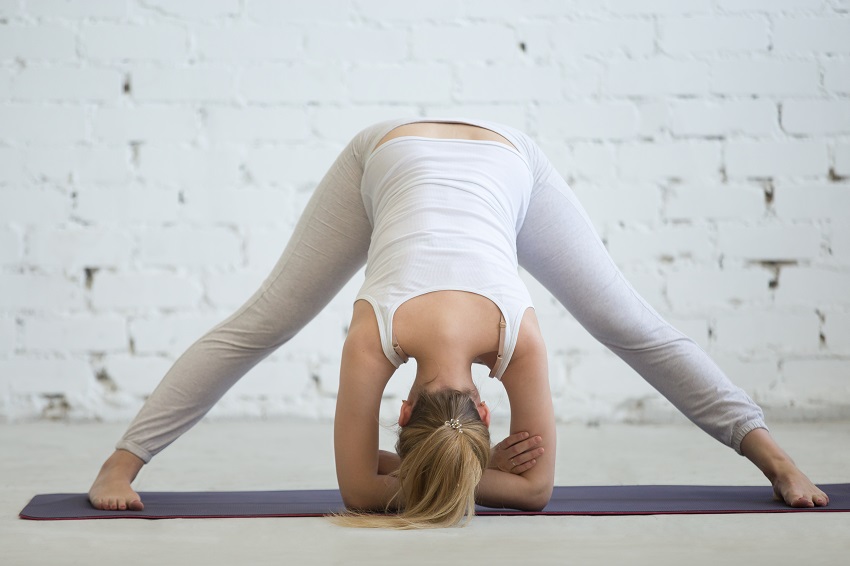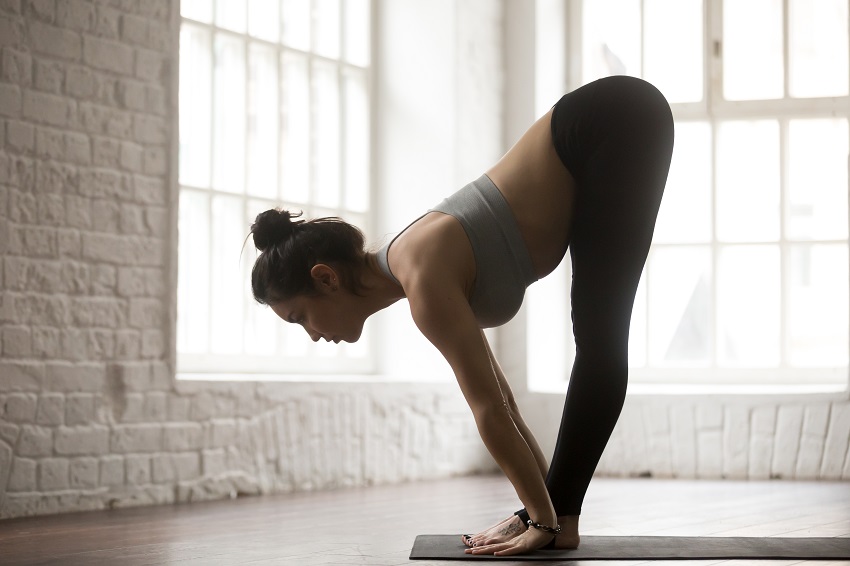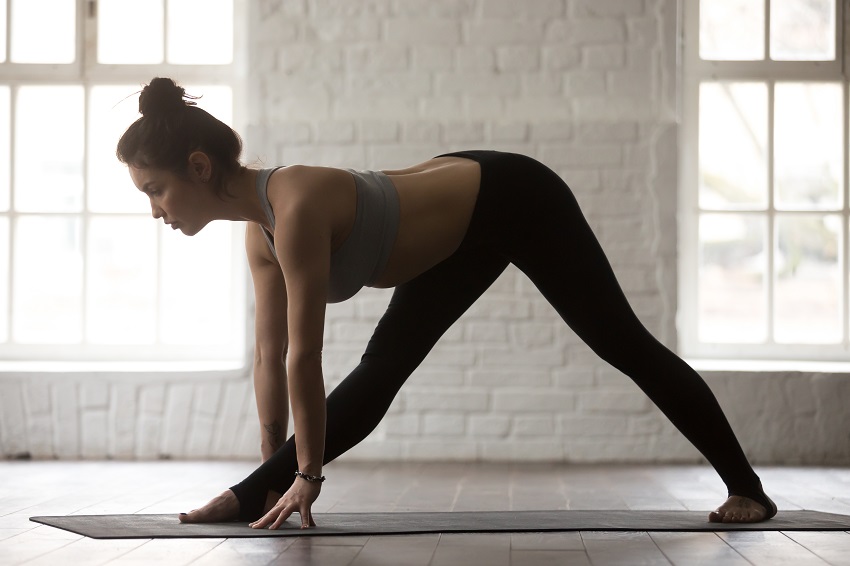Standing Forward Bend Yoga Poses:
Forward bends in yoga (both sitting and standing) serve an important purpose. In fact, these bends make up 40-50% of yoga classes. If you’re relatively knew to the practice, forward folds, consist of bringing the upper part of the body towards the lower. Furthermore, either “type” consists of the practitioner hinging at the hips (pelvic tilt), and deepening the stretch in coordination with the breath. Standing forward bend yoga poses can contribute to helping stretch, lengthen and soothe the hamstrings and back.
Furthermore, if you’ve ever participated in a yoga class or even referenced sources online, you’re aware that these “types” of poses focus on the entire back of the body. For example, the back, hamstrings, glutes, and calves.

Benefits of Forward Bends:
Psychologically they help promote calm and introspection. There are tons of variations with a range of secondary benefits, but they all follow the same basic principles. Surely, you’ve also heard them referenced to as forward folds. Most often, these terms are used interchangeably
The common aspect of all forward bends is to create a stretch in the posterior structures of our body. Thus, helping relieve tension along this area of the body. The muscles involved in this movement help support our upright position and allow the extension of the back. Poor flexibility in these areas can lead to lower back pain, stiffness, and decrease range of motion.
In fact, common touted benefits include;
- lengthening & strengthening the spine;
- improving alignment and posture;
- calming the mind (tranquility) and helping relieve stress;
- they primarily stimulate the kidneys, but also the liver, spleen, pancreas, intestines and genitals;
- may help relieve headaches, insomnia, states of anxiety and high blood pressure;
- improve digestion.
In addition, forward bends or folds can also contribute to abdominal development, as we engage them for breathing (pranayama). Engaging the core of the body help increase or stimulate circulation in that area, as well.
Remember the trunk and core of the body take on much of the workload in our daily lives. Thus, it’s important to keep these areas of the body, not only strong, but flexibility to avoid injury, and potentially prevent unwarranted discomfort. Specific fold/bends can better activate your glutes, hamstrings or lower back, while others give emphasis to the upper region of the back, or even the calves.
Standing Forward Bend Yoga Poses:
Below, we provide you 2 of the most common standing forward bend yoga poses. Surely, their are more. However, these provide a very good foundation in which to build future poses off of.
In addition to the beforementioned benefits, standing forward folds can help improve balance, coordination and concentration. As always, even though we focus on forward folds in this post, it’s important to keep in mind those counter positions, keeping your body in equilibrium.
Contraindications include recent acute or chronic injury to the back, neck, spine. Whenever engaging in new activities, or ones following injury, consult a medical expert. Insert yourself in a yoga class, and become well invested in knowledge of the practice.
Uttanasana – (Standing Forward Fold):

Steps:
- Starting point is Tadasana, the position of the mountain;
- Inhale, raise your arms. Exhale, tilt or hinge forward, keeping your legs straight;
- Attempt to push your torso forward, creating space between your pelvis and breastbone;
- It’s okay to slightly bend the knees, if new to bends. Listen to your body and respect your limits;
- When you get to what is currently your “limit”, attempt to touch the mat with your palms and try to relax your head;
- At this point, push your feet down and bring your butt up. All very gradually and delicately, do not force yourself;
- Breathing in, push your hands onto the mat, stretch forward and lift your torso by stretching the spine. Gaze forward, but be careful not to strain your neck too much;
- As you exhale, relax your upper body and lean forward as much as possible;
- As you inhale and exhale, attempt to increase your stretch;
- To return to the starting position, lift your torso with your back straight.
Parsvottanasana – (Pyramid Pose):

Steps:
- Begin, standing on the mat in Tadasana. Separate the feet slightly more than the width of the pelvis, place your hands on your hips.
- Turn the right foot to the side and the torso in the direction of the foot. Then, turn the left foot slightly behind, about 45 °. The hips remain on the same level. Be aware of the weight of the body on the feet, see if there are differences in weight distribution. This is a useful phase for becoming familiar with balance and grounding.
- Maintain your posture, pushing your feet firmly to the floor, legs straight, back straight, bend forward while continuing to stretch.
- Bring your torso parallel to the floor and look forward. Do not underestimate the stretching at this stage as it will help a lot in the following steps.
- Now, bring your hands to the floor on either side of your right foot. Continue to stretch your spine as you push your pelvis and chest down and look forward. The feet are firmly rooted on the floor and the legs do not bend.
- Slowly lean forward, without arching your spine. Rest your head on your right knee.
- Continue to stretch your back by breathing slowly and deeply. This is the final posture. Hold the position, then slowly return to the starting position by pressing on the rear heel.
- Repeat the Asana on the other side.
Final Thoughts!
Well, there you have it. Having basic knowledge on many foundational movements in yoga is key to having success early, and often. We hope these poses can then lead you to more complex asanas. Furthermore, we hope you can experience all the benefits and joys of the practice of yoga, in your life.
References:
- https://www.arhantayoga.org/blog/guide-to-forward-bends-yoga/#:~:text=safely%20and%20effectively.-,What%20is%20a%20Forward%20Bend%20in%20Yoga%3F,greatly%20in%20yoga%20forward%20bends.




